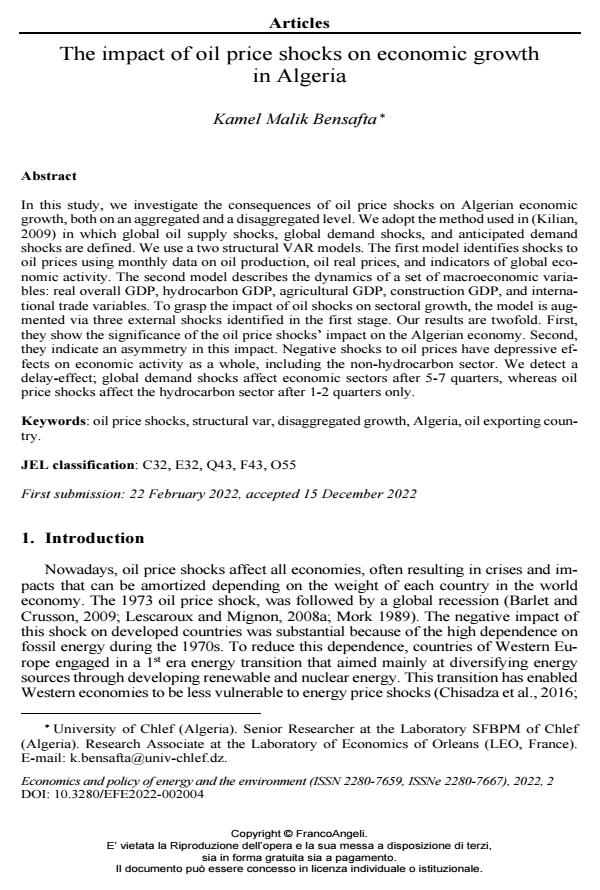The impact of oil price shocks on economic growth in Algeria
Titolo Rivista ECONOMICS AND POLICY OF ENERGY AND THE ENVIRONMENT
Autori/Curatori Kamel Malik Bensafta
Anno di pubblicazione 2023 Fascicolo 2022/2
Lingua Inglese Numero pagine 20 P. 63-82 Dimensione file 335 KB
DOI 10.3280/EFE2022-002004
Il DOI è il codice a barre della proprietà intellettuale: per saperne di più
clicca qui
Qui sotto puoi vedere in anteprima la prima pagina di questo articolo.
Se questo articolo ti interessa, lo puoi acquistare (e scaricare in formato pdf) seguendo le facili indicazioni per acquistare il download credit. Acquista Download Credits per scaricare questo Articolo in formato PDF

FrancoAngeli è membro della Publishers International Linking Association, Inc (PILA)associazione indipendente e non profit per facilitare (attraverso i servizi tecnologici implementati da CrossRef.org) l’accesso degli studiosi ai contenuti digitali nelle pubblicazioni professionali e scientifiche
In this study, we investigate the consequences of oil price shocks on Algerian economic growth, both on an aggregated and a disaggregated level. We adopt the method used in (Kilian, 2009) in which global oil supply shocks, global demand shocks, and anticipated demand shocks are defined. We use a two structural VAR models. The first model identifies shocks to oil prices using monthly data on oil production, oil real prices, and indicators of global eco- nomic activity. The second model describes the dynamics of a set of macroeconomic varia- bles: real overall GDP, hydrocarbon GDP, agricultural GDP, construction GDP, and interna- tional trade variables. To grasp the impact of oil shocks on sectoral growth, the model is aug- mented via three external shocks identified in the first stage. Our results are twofold. First, they show the significance of the oil price shocks’ impact on the Algerian economy. Second, they indicate an asymmetry in this impact. Negative shocks to oil prices have depressive ef- fects on economic activity as a whole, including the non-hydrocarbon sector. We detect a delay-effect; global demand shocks affect economic sectors after 5-7 quarters, whereas oil price shocks affect the hydrocarbon sector after 1-2 quarters only.
Parole chiave:oil price shocks, structural var, disaggregated growth, Algeria, oil exporting coun try.
Jel codes:C32, E32, Q43, F43, O55
Kamel Malik Bensafta, The impact of oil price shocks on economic growth in Algeria in "ECONOMICS AND POLICY OF ENERGY AND THE ENVIRONMENT" 2/2022, pp 63-82, DOI: 10.3280/EFE2022-002004